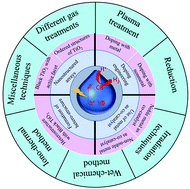Black titania an emerging photocatalyst: review highlighting the synthesis techniques and photocatalytic activity for hydrogen generation
Abstract
The TiO2 semiconductor photocatalyst is in the limelight of sustainable energy research in recent years because of its beneficial properties. However, its wide band-gap and rapid exciton recombination rate makes it a lame horse, and reduces its photocatalytic efficiency. Recently, researchers have developed facile methods for lowering the band-gap, so that it captures a wide range of solar spectrum, but the efficiency is still way behind the target value. After the discovery of black titania (B-TiO2), the associated drawbacks of white TiO2 and its modified forms were addressed to a large extent because it not only absorbs photons in a broad spectral range (UV to IR region), but also modifies the structural and morphological features, along with the electronic properties of the material, significantly boosting the catalytic performance. Hence, B-TiO2 effectively converts solar energy into renewable chemical energy i.e. green fuel H2 that can ultimately satisfy the energy crisis and environmental pollution. However, the synthesis techniques involved are quite tedious and challenging. Hence, this review summarizes various preparation methods of B-TiO2 and the involved characterization techniques. It also discusses the different modification strategies adopted to improve the H2 evolution activity, and hopes that this review acts as a guiding tool for researchers working in this field.

- This article is part of the themed collection: Recent Review Articles


 Please wait while we load your content...
Please wait while we load your content...